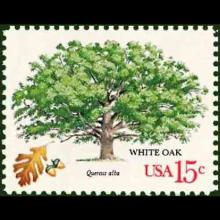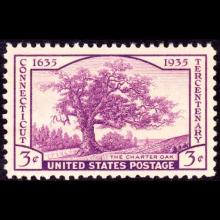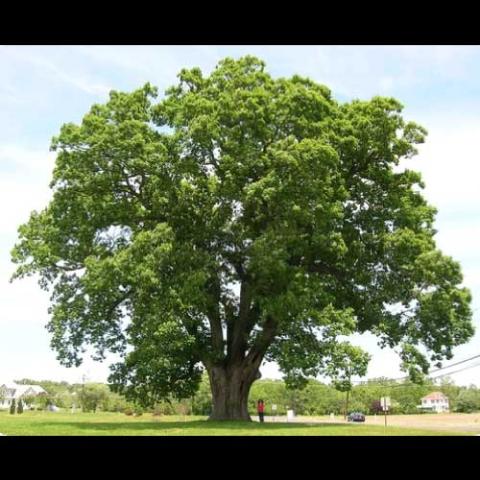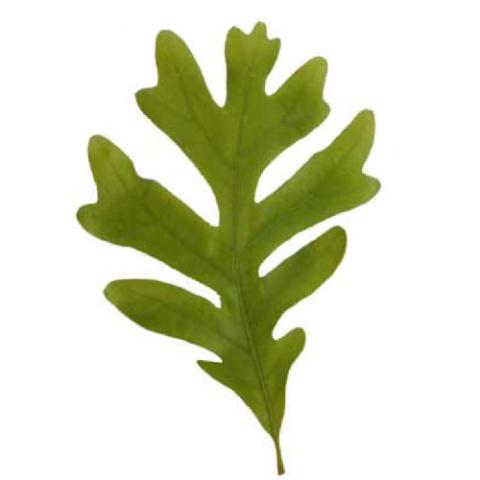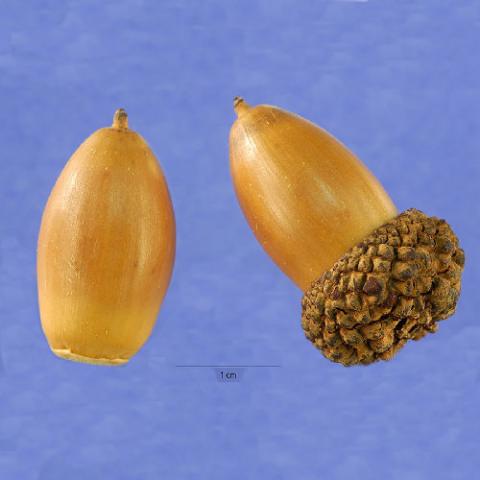NAME(S)
TAXONOMY
PLANTAE ID
THERAPEUTIC
United States
Issued:
Stamp:
Quercus alba
United States
Issued:
Stamp:
Quercus alba
United States
Issued:
Stamp:
Quercus alba
United States
Issued:
Stamp:
Quercus alba
United States
Issued:
Stamp:
Quercus alba
United States
Issued:
Stamp:
Quercus alba
Genus species (Plantae): Quercus alba
Quercus alba, the white oak, is one of the preeminent hardwoods of eastern and central North America. It is a long-lived oak, native to eastern and central North America and found from Minnesota, Ontario, Quebec, and southern Maine south as far as northern Florida and eastern Texas. Specimens have been documented to be over 450 years old.
Although called a white oak, it is very unusual to find an individual specimen with white bark; the usual color is a light grey. The name comes from the colour of the finished wood. In the forest it can reach a magnificent height and in the open it develops into a massive broad-topped tree with large branches striking out at wide angles.
Description
Quercus alba typically reaches heights of 24 to 30 meters (80–100 feet) at maturity, and its canopy can become quite massive as its lower branches are apt to extend far out laterally, parallel to the ground. Trees growing in a forest will become much taller than ones in an open area which develop to be short and massive. The Mingo Oak was the tallest known white oak at over two hundred feet with a trunk height of 44.2 m (145 ft) before it was felled in 1938. It is not unusual for a white oak tree to be as wide as it is tall, but specimens growing at high altitudes may only become small shrubs. The bark is a light ash-gray and peels somewhat from the top, bottom and/or sides.
White oak may live 200 to 300 years, with some even older specimens known. The Wye Oak in Wye Mills, Maryland was estimated to be over 450 years old when it finally fell in a thunderstorm in 2002.
Another noted white oak was the Great White Oak in Basking Ridge, New Jersey, estimated to have been over 600 years old when it died in 2016. The tree measured 8 m (25 ft) in circumference at the base and 5 m (16 ft) in circumference 1.2 m (4 ft) above the ground. The tree was 23 m (75 ft) tall, and its branches spread over 38 m (125 ft) from tip to tip. The oak, claimed to be the oldest in the United States, began showing signs of poor health in the mid-2010s.[10] The tree was taken down in 2017.
Sexual maturity begins at around 20 years, but the tree does not produce large crops of acorns until its 50th year and the amount varies from year to year. Acorns deteriorate quickly after ripening, the germination rate being only 10% for six-month-old seeds. As the acorns are prime food for insects and other animals, all may be consumed in years of small crops, leaving none that would become new trees.[12] The acorns are usually sessile, and grow to 15 to 25 mm (1⁄2–1 in) in length, falling in early October.
In spring, the young leaves are delicate, silvery pink, and covered with a soft blanket-like down. The petioles are short, and the clustered leaves close to the ends of the shoots are pale green and downy, resulting in the entire tree having a misty, frosty look. This condition continues for several days, passing through the opalescent changes of soft pink, silvery white, and finally, yellow green. The leaves grow to be 127 to 216 mm (5–8+1⁄2 inches) long and 7 to 11.5 cm (2+3⁄4–4+1⁄2 in) wide and have a deep glossy green upper surface. They usually turn red or brown in autumn, but depending on climate, site, and individual tree genetics, some trees are nearly always red, or even purple in autumn. Some dead leaves may remain on the tree throughout winter until very early spring. The lobes can be shallow, extending less than halfway to the midrib, or deep and somewhat branching.
Quercus alba is sometimes confused with the swamp white oak, a closely related species, and the bur oak. The white oak hybridizes freely with the bur oak, the post oak, and the chestnut oak.
Distribution
Quercus alba is fairly tolerant of a variety of habitats, and may be found on ridges, in valleys, and in between, in dry and moist habitats, and in moderately acid and alkaline soils. It is mainly a lowland tree, but reaches altitudes of 1,600 m (5,249 ft) in the Appalachian Mountains. It is often a component of the forest canopy in an oak-heath forest.
Frequent fires in the Central Plains region of the United States prevented oak forests, including Quercus alba, from expanding into the Midwest. However, a decrease in the frequency of these natural fires after European settlement caused rapid expansion of oak forests into the Great Plains, negatively affecting the natural prairie vegetation.
Uses
Cultivation
Quercus alba is cultivated as an ornamental tree somewhat infrequently due to its slow growth and ultimately huge size. It is not tolerant of urban pollution and road salt and due to its large taproot, is unsuited for a street tree or parking strips/islands.
Food
The acorns are much less bitter than the acorns of red oaks. They can be eaten by humans but, if bitter, may need to have the tannins leached. They are also a valuable wildlife food, notably for turkeys, wood ducks, pheasants, grackles, jays, nuthatches, thrushes, woodpeckers, rabbits, squirrels, and deer. The white oak is the only known food plant of the Bucculatrix luteella and Bucculatrix ochrisuffusa caterpillars.
The young shoots of many eastern oak species are readily eaten by deer. Dried oak leaves are also occasionally eaten by white-tailed deer in the fall or winter. Rabbits often browse twigs and can girdle stems.[20]
Woodcraft
White oak has tyloses that give the wood a closed cellular structure, making it water- and rot-resistant. Because of this characteristic, white oak is used by coopers to make wine and whiskey barrels as the wood resists leaking. It has also been used in construction, shipbuilding, agricultural implements and in the interior finishing of houses.[5] White oak splints have been used historically by Native Americans for basketry.
White oak logs feature prominent medullary rays which produce a distinctive, decorative ray and fleck pattern when the wood is quarter sawn. Quarter sawn white oak was a signature wood used in mission style oak furniture by Gustav Stickley in the Craftsman style of the Arts and Crafts movement.
White oak is used extensively in Japanese martial arts for some weapons, such as the bokken and jo. It is valued for its density, strength, resiliency and relatively low chance of splintering if broken by impact, relative to the substantially cheaper red oak.
USS Constitution is made of white oak and southern live oak, conferring additional resistance to cannon fire. Reconstructive wood replacement of white oak parts comes from a special grove of Quercus alba known as the "Constitution Grove" at Naval Surface Warfare Center Crane Division.
Musical Instruments
Deering Banjo Company have made several 5-string banjos using white oak - including members of the Vega series, the White Lotus, and the limited edition 40th anniversary model. White Oak has a mellower timbre than more traditionally used maple, and yet still has enough power and projection to not require a metal tone ring.
Oak Barrels
Barrels made of American white oak are commonly used for oak aging of wine, in which the wood is noted for imparting strong flavors.[25] Also, by federal regulation, bourbon whiskey must be aged in charred new oak (generally understood to mean specifically American white oak) barrels.
Culture
White oak has served as the official state tree of Illinois after selection by a vote of school children.[27] There are two "official" white oaks serving as state trees, one located on the grounds of the governor's mansion, and the other in a schoolyard in the town of Rochelle. The white oak is also the state tree of Connecticut[28] and Maryland. The Wye Oak, probably the oldest living white oak until it fell because of a thunderstorm on June 6, 2002, was the honorary state tree of Maryland.
Being the subject of a legend as old as the colony itself, the Charter Oak of Hartford, Connecticut is one of the most famous white oaks in America. An image of the tree now adorns the reverse side of the Connecticut state quarter.
The white oak from the movie The Shawshank Redemption, known as the "Shawshank tree" and the "Tree of Hope", was estimated to be more than 200 years old when it fell. The tree is seen during the last ten minutes of the movie. As the movie gained fame, the tree became popular as well, and used to attract tens of thousands of movie fans and tourists every year. A portion of the tree came down on July 29, 2011, when the tree was split by lightning during a storm. The remaining half of the tree fell during heavy winds just short of five years later, on July 22, 2016.
The Bedford Oak is a 500-year-old white oak tree that sits in the town of Bedford in New York. It is the mascot of the town. It sits at the corner of the Hook Road and the old Bedford Road (now Cantitoe Street). The ground the tree stands on was deeded to the Town of Bedford in 1942 by Harold Whitman in memory of his wife, Georgia Squires Whitman. It has seen Westchester history from Native American settlements to the Revolutionary War to modern times.
In the 2009 video game Ace Attorney Investigations: Miles Edgeworth, there is a character named Quercus Alba who bears some resemblance to the white oak and plants in general.
Reference: Wikipedia, pfaf.org, White Rabbit Institute of Healing, plants.usda.gov

